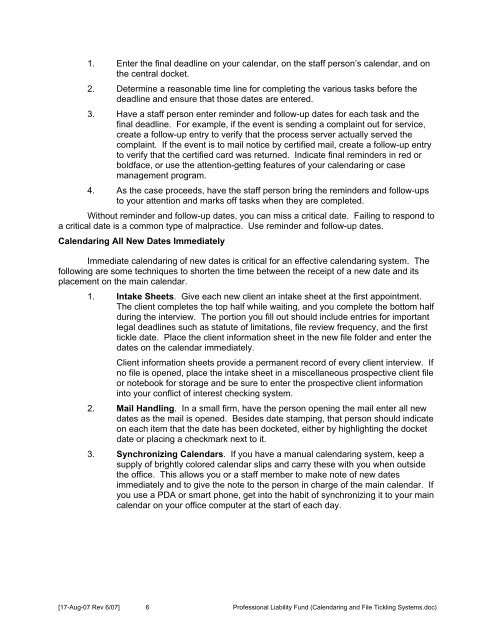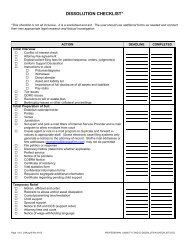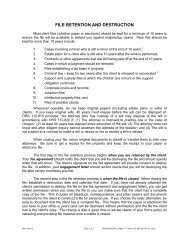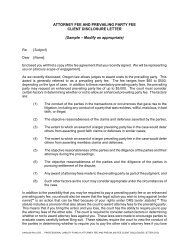Calendaring, Docketing, and File Tickling Systems - Professional ...
Calendaring, Docketing, and File Tickling Systems - Professional ...
Calendaring, Docketing, and File Tickling Systems - Professional ...
Create successful ePaper yourself
Turn your PDF publications into a flip-book with our unique Google optimized e-Paper software.
1. Enter the final deadline on your calendar, on the staff person’s calendar, <strong>and</strong> onthe central docket.2. Determine a reasonable time line for completing the various tasks before thedeadline <strong>and</strong> ensure that those dates are entered.3. Have a staff person enter reminder <strong>and</strong> follow-up dates for each task <strong>and</strong> thefinal deadline. For example, if the event is sending a complaint out for service,create a follow-up entry to verify that the process server actually served thecomplaint. If the event is to mail notice by certified mail, create a follow-up entryto verify that the certified card was returned. Indicate final reminders in red orboldface, or use the attention-getting features of your calendaring or casemanagement program.4. As the case proceeds, have the staff person bring the reminders <strong>and</strong> follow-upsto your attention <strong>and</strong> marks off tasks when they are completed.Without reminder <strong>and</strong> follow-up dates, you can miss a critical date. Failing to respond toa critical date is a common type of malpractice. Use reminder <strong>and</strong> follow-up dates.<strong>Calendaring</strong> All New Dates ImmediatelyImmediate calendaring of new dates is critical for an effective calendaring system. Thefollowing are some techniques to shorten the time between the receipt of a new date <strong>and</strong> itsplacement on the main calendar.1. Intake Sheets. Give each new client an intake sheet at the first appointment.The client completes the top half while waiting, <strong>and</strong> you complete the bottom halfduring the interview. The portion you fill out should include entries for importantlegal deadlines such as statute of limitations, file review frequency, <strong>and</strong> the firsttickle date. Place the client information sheet in the new file folder <strong>and</strong> enter thedates on the calendar immediately.Client information sheets provide a permanent record of every client interview. Ifno file is opened, place the intake sheet in a miscellaneous prospective client fileor notebook for storage <strong>and</strong> be sure to enter the prospective client informationinto your conflict of interest checking system.2. Mail H<strong>and</strong>ling. In a small firm, have the person opening the mail enter all newdates as the mail is opened. Besides date stamping, that person should indicateon each item that the date has been docketed, either by highlighting the docketdate or placing a checkmark next to it.3. Synchronizing Calendars. If you have a manual calendaring system, keep asupply of brightly colored calendar slips <strong>and</strong> carry these with you when outsidethe office. This allows you or a staff member to make note of new datesimmediately <strong>and</strong> to give the note to the person in charge of the main calendar. Ifyou use a PDA or smart phone, get into the habit of synchronizing it to your maincalendar on your office computer at the start of each day.[17-Aug-07 Rev 6/07] 6 <strong>Professional</strong> Liability Fund (<strong>Calendaring</strong> <strong>and</strong> <strong>File</strong> <strong>Tickling</strong> <strong>Systems</strong>.doc)
















